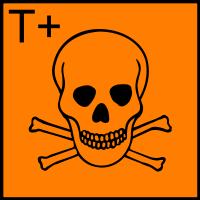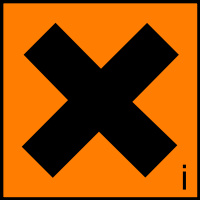|
Storage Condition
|
|
0°C
|
 Show
data source Show
data source
|
|
Refrigerator
|
 Show
data source Show
data source
|
|
|
Storage Warning
|
|
Moisture Sensitive
|
 Show
data source Show
data source
|
|
Very Toxic/Flammable/Irritant/Corrosive/Moisture Sensitive/Air Sensitive/Keep Cold/Store under Argon
|
 Show
data source Show
data source
|
|
|
RTECS
|
|
HT0230000
|
 Show
data source Show
data source
|
|
|
European Hazard Symbols
|
 Flammable (F) Flammable (F)
|
 Show
data source Show
data source
|
 Highly toxic (T+) Highly toxic (T+)
|
 Show
data source Show
data source
|
 Irritant (Xi) Irritant (Xi)
|
 Show
data source Show
data source
|
|
|
UN Number
|
|
1992
|
 Show
data source Show
data source
|
|
1993
|
 Show
data source Show
data source
|
|
2810
|
 Show
data source Show
data source
|
|
2929
|
 Show
data source Show
data source
|
|
UN2930
|
 Show
data source Show
data source
|
|
|
MSDS Link
|
|
|
German water hazard class
|
|
3
|
 Show
data source Show
data source
|
|
|
Hazard Class
|
|
3
|
 Show
data source Show
data source
|
|
6.1
|
 Show
data source Show
data source
|
|
|
Packing Group
|
|
1
|
 Show
data source Show
data source
|
|
2
|
 Show
data source Show
data source
|
|
I
|
 Show
data source Show
data source
|
|
III
|
 Show
data source Show
data source
|
|
|
Australian Hazchem
|
|
3Y
|
 Show
data source Show
data source
|
|
|
Risk Statements
|
|
10-26-36/37/38-43
|
 Show
data source Show
data source
|
|
11-19-26-36/37/38-43
|
 Show
data source Show
data source
|
|
11-26-36/37/38-43
|
 Show
data source Show
data source
|
|
11-26-37/38-41-43
|
 Show
data source Show
data source
|
|
26-36/37/38-40-43
|
 Show
data source Show
data source
|
|
R:10-36/37/38
|
 Show
data source Show
data source
|
|
|
Safety Statements
|
|
16-26-28-36/37-45
|
 Show
data source Show
data source
|
|
26-28-36/37-45
|
 Show
data source Show
data source
|
|
7/9-16-26-28-36/37-45
|
 Show
data source Show
data source
|
|
9-26-28-36/37/39-45-60
|
 Show
data source Show
data source
|
|
S:16-20-25-26-37/39
|
 Show
data source Show
data source
|
|
|
EU Classification
|
|
F1
|
 Show
data source Show
data source
|
|
|
EU Hazard Identification Number
|
|
3B
|
 Show
data source Show
data source
|
|
|
Emergency Response Guidebook(ERG) Number
|
|
128
|
 Show
data source Show
data source
|
|
|
TSCA Listed
|
|
是
|
 Show
data source Show
data source
|
|
|
GHS Pictograms
|

|
 Show
data source Show
data source
|

|
 Show
data source Show
data source
|

|
 Show
data source Show
data source
|

|
 Show
data source Show
data source
|
|
|
GHS Signal Word
|
|
Danger
|
 Show
data source Show
data source
|
|
|
Main Hazard
|
|
toxic on inhalation T+
|
 Show
data source Show
data source
|
|
|
GHS Hazard statements
|
|
H225-H315-H319-H330-H335
|
 Show
data source Show
data source
|
|
H225-H315-H319-H330-H335-H336
|
 Show
data source Show
data source
|
|
H226-H315-H317-H319-H330-H335
|
 Show
data source Show
data source
|
|
H315-H319-H330-H335-H351
|
 Show
data source Show
data source
|
|
H330-H315-H317-H335-H318-H228
|
 Show
data source Show
data source
|
|
|
GHS Precautionary statements
|
|
P210-P260-P284-P305 + P351 + P338-P310
|
 Show
data source Show
data source
|
|
P260-P280-P284-P305 + P351 + P338-P310
|
 Show
data source Show
data source
|
|
P260-P281-P284-P305 + P351 + P338-P310
|
 Show
data source Show
data source
|
|
P280-P305+P351+P338-P302+P352-P304+P340-P310
|
 Show
data source Show
data source
|
|
|
Personal Protective Equipment
|
|
Eyeshields, Faceshields, full-face respirator (US), Gloves, multi-purpose combination respirator cartridge (US), type ABEK (EN14387) respirator filter
|
 Show
data source Show
data source
|
|
|
RID/ADR
|
|
UN 1992 3/PG 2
|
 Show
data source Show
data source
|
|
UN 2810 6.1/PG 1
|
 Show
data source Show
data source
|
|
UN 2929 6.1/PG 1
|
 Show
data source Show
data source
|
|
|
Supplemental Hazard Statements
|
|
May form explosive peroxides.
|
 Show
data source Show
data source
|
|
|
Storage Temperature
|
|
2-8°C
|
 Show
data source Show
data source
|
|